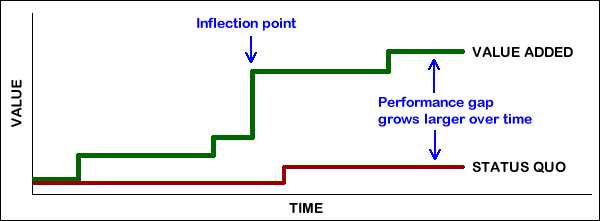In times of rapid change, there is no such thing as maintaining the “status quo.” In order to add value to your work, you must be committed to continuous learning and growth. If you decide to stand still in your knowledge, relationships and experience, you will soon fall behind and will be at a significant advantage, as the chart above illustrates.
In this diagram, the green line represents the path of someone who has decided to stay on the cutting edge of technology and learning, while the red line is someone who has decided they know enough. He or she is no longer growing. As you can see, they start out very close in performance, but over time, the cumulative growth of our innovative person takes on almost an exponential curve. Like interest in a savings account, knowledge and experience has a compounding effect. It enables the innovator to do and be so much more over time.
Inflection points exacerbate the problem
The problem gets even worse if there is an inflection point in the core technology or business model that dominates your industry or profession. What’s an inflection point? In calculus, it’s a change in direction of a curve from concave to convex, or vice versa. In business, it is a significant and disruptive change in the marketplace, often caused by technology.
Think of the move from horse-drawn carriages to automobiles at the dawn of the 20th century, vacuum tubes to integrated electronics in the 1960s and the digital music revolution in the last decade. During and after an inflection point, the rules of game suddenly change. If you can figure out the new rules of doing business and play by them (or help to shape them), you can usually leverage a huge advantage. Because you have equipped yourself with knowledge early on, your unique skills will be in high demand. If you don’t make the transition and learn how to adapt to the changes, you’re suddenly at a significant disadvantage. To quote Eric Hoffer:
“In a time of drastic change it is the learners who inherit the future. The learned usually find themselves equipped to live in a world that no longer exists.”
Adapt and thrive – or ignore and stagnate
In other words, the people who think there isn’t change afoot (the learned) continue to play by the existing rules, while those who embrace change and the new technology or business model do an end run on them and are well positioned to thrive going forward.
Back to our chart: During an inflection point, the innovator suddenly leaps ahead in productivity and results, while the other person at first lags behind and then, belatedly, makes a slight course correction in response to the disruption. But he or she never commits wholeheartedly to the New World Order and is soon marginalized.
What about you?
So where do you stand? Are you desperately trying to hang on to the way you’ve always done things, or are you trying to anticipate and respond to the changes that are unfolding all around you? It’s time to make a commitment to growth and change!

